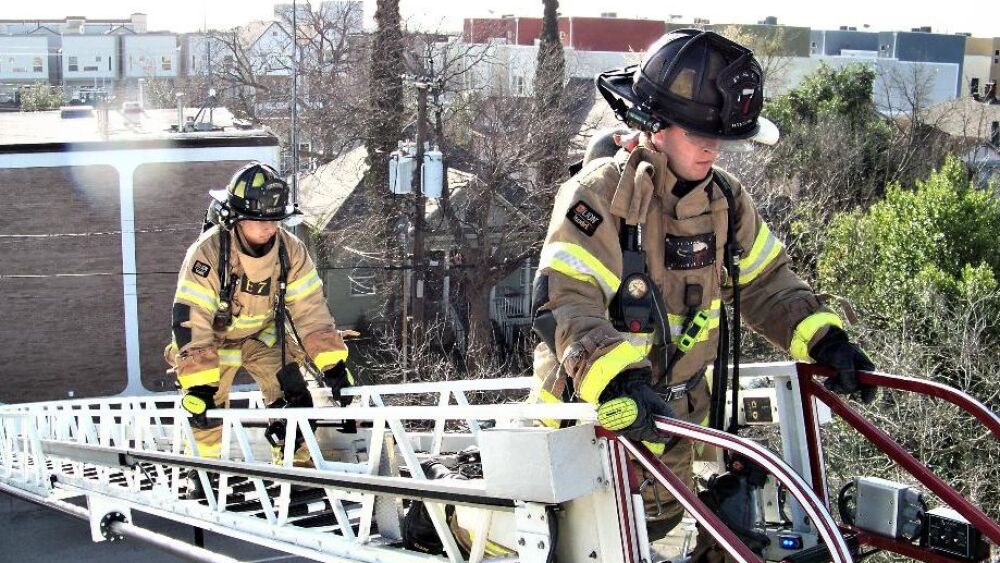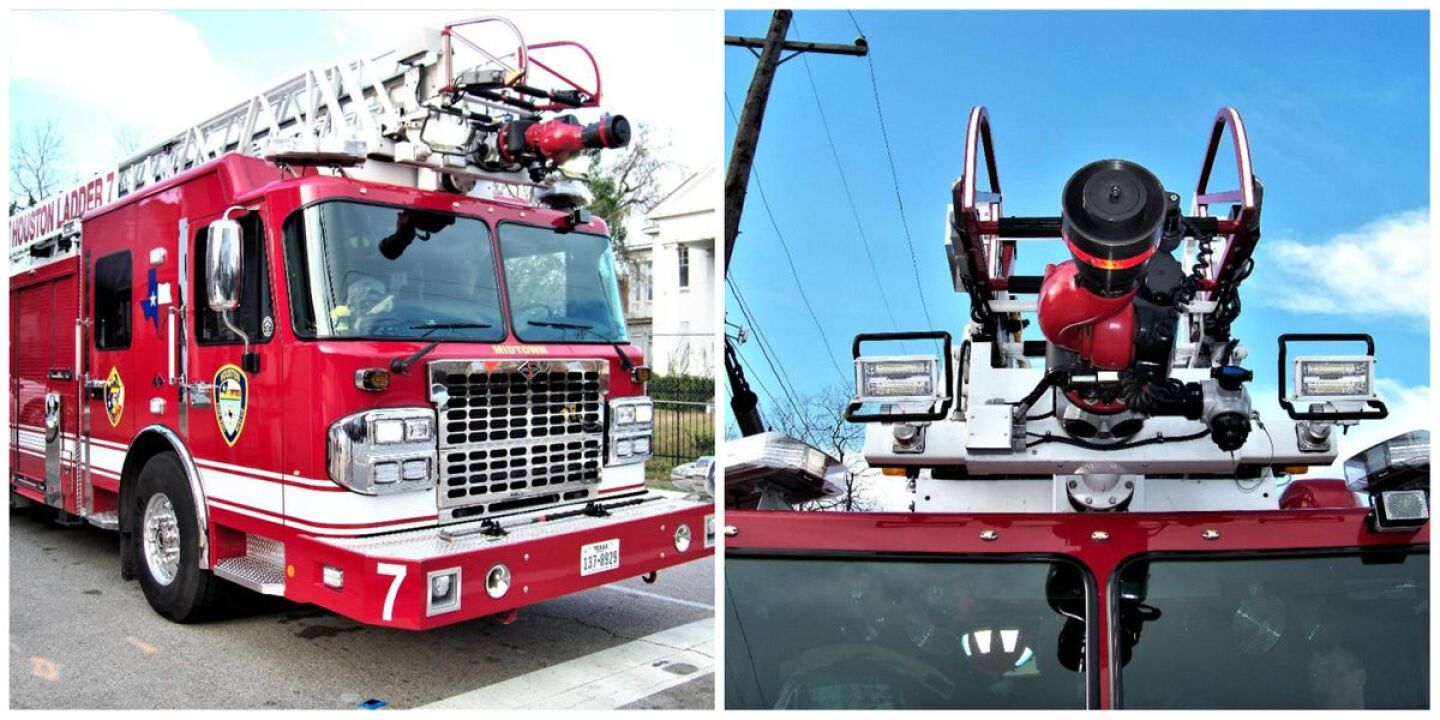Multiple meetings, several trips to the manufacturing facility, hundreds of staff hours, thousands of taxpayer dollars in overtime and approximately $1.5 million later, you have it – an aerial device worthy of the men and women who will ride in it on a daily basis serving the taxpayers who paid for it.
What typically does not come with that shiny new apparatus, however, is experience, understanding and a plan, as in, how are we going to train on this new device? How are we going to operate? What tactics are acceptable? More often than not, the bosses and decision-makers have never been assigned to an aerial device and have no clue what it’s capable of, much less what is an appropriate use or tactic.
Here we’ll focus on ladder pipes – aerial ladders with a pre-piped waterway capable of flowing water from a nozzle-mounted at the tip, more precisely, the tip of the ladder.
Flowing water from the tip
I see it all too often. It’s frustrating. It’s comical. If they knew any better, they’d know to be embarrassed. I see firefighters operating ladders with pre-piped waterways in the most inefficient and ineffective method.
And the reality is, it’s not safe. If you order a crew to use a ladder pipe and then allow them to just randomly extend and start flowing, you have no business on the fireground, and they have no business operating such a piece of equipment.
I say this because I have seen enough of it. I have seen crews start flowing, and the nozzle is initially nowhere near the intended target – flowing into the front yard, sending flower beds and small shrubs into the air, flowing onto the wrong building, breaking windows and flooding the neighbor’s living room, striking firefighters operating at ground level, hitting roofs of potential exposures not yet involved and, yes, flowing straight into the sky.
The most frustrating example I can give you, though, is when members flow onto an intact roof that has self-vented through a small hole. Seriously, you couldn’t choose a smaller or less effective target. The roof is literally designed to shed water!
Such actions show a complete lack of training and understanding on the officers’ and chiefs’ part to not have a firefighter on the tip of the ladder pipe operating the nozzle.
To remind or educate some of the officers and chiefs out there who continue to operate this way, I would like to point out a few features you may not be aware of that routinely come with that flashy $1.5 million piece of equipment.
These features are not only NFPA-approved, but many are required. Imagine that, having required safety features on a piece of equipment intended to be used a certain way. The mere existence of these features should alert a chief or company officer that putting a member on the ladder tip to operate the nozzle is the normal practice that makes fireground operations safer and more efficient:
- Ladder belts: There are a couple options on the ladder belt. The old standby is still available, but there are also newer, more slim-lined versions available that are NFPA-approved.
- Foot plates: Near the tip of the ladder and waterway are fold-down foot plates that, when positioned properly, provide the firefighter with plenty of stable standing room.
- Shut-off valve: Yes, shut-off valves are available to allow for safe operation. The ladder pipe can be charged all the way to the nozzle without flowing a single drop of water prior to aiming the nozzle in a precise direction.
- Remote controls: Also near the tip of the ladder are the remote controls that allow the firefighter the ability to deliver a precise hit on any target they deem worthy.
- Intercom: Another feature that is typically underutilized or used incorrectly is the intercom. This little feature makes communications between the pedestal and firefighter assigned to the nozzle possible without tying up fireground communications.
- Rating: Every aerial device comes with one of these. It is not a device per se, but it is useful information. The rating for such aerials is typically 500-750 lbs. with water flowing, giving a safe working load while operating on the tip/nozzle.
In addition to these features, newer ladder pipes come with many options. I have seen ladder tips with enough lights to illuminate a high school football field on a Friday night. Add in the intercom, nozzle controls and electrical outlets, and you have yourself a very useful set-up.
A word of caution: Adding options without truly studying them could very well render your ladder useful for only one operation or another. We want our ladder pipe not only for flowing water, but also available for rescue. Adding a bunch of options to the tip of the ladder without really looking at the big picture could limit the ability to place the ladder where you want it when trying to perform access or rescue. One example: Lights permanently mounted to the tip of the ladder could interfere with firefighters making a safe exit from the tip. Ladder placement is not always perfect. The 12 inches that the lights extend from the side of the ladder could make exiting the ladder unsafe by not allowing for optimal tip placement. Instead, mount the lights on the last intermediate fly section.
Another option to consider is the ladder pipe itself. It can often make using the ladder for access and rescue difficult and, at times, unsafe due to poor ladder placement.
Spec a ladder pipe that allows for the nozzle to travel with the tip for water operations, and switch modes to travel with the last intermediate fly section, leaving the tip wide open for rescue and access operations.
Unacceptable aerial tactics
Regarding tactics, you want to know what’s not OK?
Flowing water into a small vent hole on a block-long burning building while the fire continues to grow and spread! You want to know what every firefighter who “gets it” is thinking when they see this on the news? They are thinking that you absolutely don’t “get it.” You should not be flowing into any small holes in the roof.

At the tip of many ladder pipes, you can also find many of these features that make aerial master stream operations safer: The control panel allows a firefighter at the tip to direct the nozzle exactly where they want it before flowing any water; the hands-free speaker allows for communications with the turntable operator; and valves located on the nozzle itself allow the firefighter on the tip to slowly open the nozzle in a safe and control manner.
Another practice that is not acceptable – and another example of poor leadership and lack of training or understanding – is when an officer or chief is constantly on the radio telling the operator on the pedestal to move the tip left, right, up, down, go back, no up! Listening to a chief do this for 15-20 minutes is not only frustrating for everyone on scene, it’s embarrassing! Please stop it!
Put that firefighter on the tip! They will be in a better position (literally) than anyone else on the fireground to pick the targets and hit with better precision than the operator at the pedestal or an officer standing in the street yelling directions to the pedestal.
And chiefs, let’s stop having these contests to see whose aerial device can go higher. A two-story warehouse does not warrant full extension of a 100-foot ladder pipe and 75-degree elevation to apply water. It is actually counterproductive.
Offensive ladder pipe operations
Instead of waiting for defensive operations, chiefs and officers should prepare for and position aerials for a more aggressive operation. Let’s retract or lower those ladder pipes so you can punch the fire in the throat instead of sprinkling hope everywhere.
Place that tip in a location to cut off the spread of the fire. Starting in the middle of the roof is not a tactically beneficial approach to successful operations.
Instead of flowing through small holes in the roof that is designed to shed water, you should be flowing below the roof line through the ceiling instead. Lower or position the aerial device to flow through gables and windows. Place the tip of the aerial in a position so that a firefighter on the tip can first open a cockloft or void space below the roof line, and then flow into the opening that he just created. This technique is much more effective than that small hole that self-vented through the roof. You are now applying water directly into or on a much larger target area.
Train your department to understand the capabilities and all operational tactics of your aerial. Train so that there is complete understanding.
Having said that, I would like to touch on something that many see as controversial – moving the ladder while a firefighter is on the tip. Most people are against it. But from my perspective, it is acceptable if you train regularly and understand all the precautions necessary to make it a safe practice. Up, down, left and right should not be a question in anybody’s mind. It is safe. Extension and retraction are safe as well, as long as the firefighter and footplates have cleared the last intermediate fly section.
I believe it is an acceptable practice because we are professionals. I believe this tactic is safe because we train. I also believe this tactic is acceptable because such movements are done in a slow, calculated manner. These movements also require verbal communications with the firefighter at the tip and the operator at the pedestal.

It is absolutely safe to assign firefighters to the tip of the ladder during aerial master stream operations. Most aerials are rated for 500 pounds while flowing water. It is also acceptable to raise lower and rotate while a firefighter is on the tip. Such operations will typically be slow movements.
Movement with a firefighter on the tip should not include doing a 360-degree rotation, but rather slow, calculated movements from window to window or floor to floor.
These actions are made safer and confidence is gained with training as well. I believe this tactic is critical because structures are burning faster and leaving less time for occupants to escape. They called us because we are literally the only ones that can help them. They expect us to be there and be professional.
And let me be clear: I am not suggesting we treat our ladders like carnival rides. I am only referring to those times that it is expedient and advantageous to our desired outcomes. Climbing up and down on the ladder just to move it to some other location on your typical building is neither expedient nor advantageous to our desired outcome.
Finally, there are situations in which we should not put a firefighter on the tip: hazmat incidents, burning tank cars, burning 18-wheelers, and some processing and storage facilities. We have seen these operations end poorly on multiple occasions.
Pumping into or charging the ladder pipe
This is an operation that should be done slowly and with communications. Operators want to avoid excessive water hammer on the ladder pipe plumbing. Seals can be damaged to the point that the ladder pipe is of no use. Also, the waterway itself can be damaged beyond use.
Charge the ladder pipe slowly. If it is a quint, the operator can handle this alone. If an engine company is pumping into the ladder pipe, this method requires communications and understanding beyond the typical “charge it!” call.
Avoiding damage to the equipment should always be a top priority of operators.
Staffing plan
A staffing plan is just as important as the initial specification of the aerial. No aerial should sit unstaffed in a professional organization. Even if the plan is to only staff it with an engineer, that is a better plan than leaving it in the station when the tones go off.
Volunteer organizations should have the same plan when it comes to staffing.
Aerial training
Chief and company officers need to understand and accept that it’s OK to assign a firefighter to the tip/nozzle on your ladder pipe! In fact, it should be the guideline. Train for it! The entire department should understand that it is an acceptable practice.
Experience does not come with the purchase of an aerial device either. So, training will be the only experience. Train a lot. Get the experience through your training.
More than a specialty apparatus
Your department’s aerial device should not be viewed as a specialty apparatus. It should not be viewed as a piece of equipment that responds only to the “big one.” It should not be considered a department’s prized possession. It is not a parade apparatus. It is not intended to sit there collecting dust.
The aerial should be viewed as a piece of equipment that complements the first-out engine. It should be included on every structure fire response. Aerials can serve a purpose on even a one-story residential with today’s construction methods. Have an open mind with your deployment. If it works, it’s not stupid.
The aerial belongs to the taxpayers. The taxpayers expect your members to be proficient in its use, understand everything about it and use it accordingly. It is your job to make sure they do.
Train your members, trust in your members’ training, experience and abilities to make the right decisions, then allow them to make those decisions. Train to stay safe.
Editor’s Note: What’s your aerial advice? Share in the comments below.






